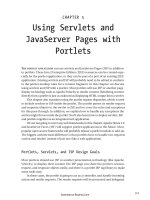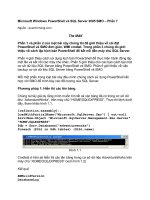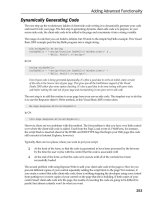Core Servlets and JavaServer Pages phần 7 pptx
Bạn đang xem bản rút gọn của tài liệu. Xem và tải ngay bản đầy đủ của tài liệu tại đây (3.91 MB, 62 trang )
344 Chapter 14 Creating Custom JSP Tag Libraries
Home page for this book: www.coreservlets.com; Home page for sequel: www.moreservlets.com.
Servlet and JSP training courses by book’s author: courses.coreservlets.com.
© Prentice Hall and Sun Microsystems. Personal use only; do not redistribute.
Now, suppose that we want to define a set of tags that would be used like
this:
<csajsp:if>
<csajsp:condition><%= someExpression %></csajsp:condition>
<csajsp:then>JSP to include if condition is true</csajsp:then>
<csajsp:else>JSP to include if condition is false</csajsp:else>
</csajsp:if>
To accomplish this task, the first step is to define an IfTag class to handle
the
csajsp:if tag. This handler should have methods to specify and check
whether the condition is true or false (
setCondition and getCondition) as
well as methods to designate and check if the condition has ever been explic-
itly set (
setHasCondition and getHasCondition), since we want to disal-
low
csajsp:if tags that contain no csajsp:condition entry. Listing 14.23
shows the code for
IfTag.
The second step is to define a tag handler for csajsp:condition. This
class, called
IfConditionTag, defines a doStartTag method that merely
checks if the tag appears within
IfTag. It returns EVAL_BODY_TAG if so and
throws an exception if not. The handler’s
doAfterBody method looks up
the body content (
getBodyContent), converts it to a String (getString),
and compares that to
"true". This approach means that an explicit value of
true can be substituted for a JSP expression like <%= expression %> if,
during initial page development, you want to temporarily designate that the
then portion should always be used. Using a comparison to "true" also
means that any other value will be considered “false.” Once this compari-
son is performed, the result is stored in the enclosing tag by means of the
setCondition method of IfTag. The code for IfConditionTag is shown
in Listing 14.24.
The third step is to define a class to handle the csajsp:then tag. The
doStartTag method of this class verifies that it is inside IfTag and also
checks that an explicit condition has been set (i.e., that the
IfConditionTag
has already appeared within the IfTag). The doAfterBody method checks
for the condition in the
IfTag class, and, if it is true, looks up the body con-
tent and prints it. Listing 14.25 shows the code.
The final step in defining tag handlers is to define a class for csa-
jsp:else
. This class is very similar to the one to handle the then part of
the tag, except that this handler only prints the tag body from
doAfterBody
if the condition from the surrounding IfTag is false. The code is shown in
Listing 14.26.
Simpo PDF Merge and Split Unregistered Version -
14.8 Using Nested Tags 345
© Prentice Hall and Sun Microsystems. Personal use only; do not redistribute.
Home page for this book: www.coreservlets.com; Home page for sequel: www.moreservlets.com.
Servlet and JSP training courses by book’s author: courses.coreservlets.com.
Listing 14.23 IfTag.java
package coreservlets.tags;
import javax.servlet.jsp.*;
import javax.servlet.jsp.tagext.*;
import java.io.*;
import javax.servlet.*;
/** A tag that acts like an if/then/else.
*/
public class IfTag extends TagSupport {
private boolean condition;
private boolean hasCondition = false;
public void setCondition(boolean condition) {
this.condition = condition;
hasCondition = true;
}
public boolean getCondition() {
return(condition);
}
public void setHasCondition(boolean flag) {
this.hasCondition = flag;
}
/** Has the condition field been explicitly set? */
public boolean hasCondition() {
return(hasCondition);
}
public int doStartTag() {
return(EVAL_BODY_INCLUDE);
}
}
Simpo PDF Merge and Split Unregistered Version -
346 Chapter 14 Creating Custom JSP Tag Libraries
Home page for this book: www.coreservlets.com; Home page for sequel: www.moreservlets.com.
Servlet and JSP training courses by book’s author: courses.coreservlets.com.
© Prentice Hall and Sun Microsystems. Personal use only; do not redistribute.
Listing 14.24 IfConditionTag.java
package coreservlets.tags;
import javax.servlet.jsp.*;
import javax.servlet.jsp.tagext.*;
import java.io.*;
import javax.servlet.*;
/** The condition part of an if tag.
*/
public class IfConditionTag extends BodyTagSupport {
public int doStartTag() throws JspTagException {
IfTag parent =
(IfTag)findAncestorWithClass(this, IfTag.class);
if (parent == null) {
throw new JspTagException("condition not inside if");
}
return(EVAL_BODY_TAG);
}
public int doAfterBody() {
IfTag parent =
(IfTag)findAncestorWithClass(this, IfTag.class);
String bodyString = getBodyContent().getString();
if (bodyString.trim().equals("true")) {
parent.setCondition(true);
} else {
parent.setCondition(false);
}
return(SKIP_BODY);
}
}
Simpo PDF Merge and Split Unregistered Version -
14.8 Using Nested Tags 347
© Prentice Hall and Sun Microsystems. Personal use only; do not redistribute.
Home page for this book: www.coreservlets.com; Home page for sequel: www.moreservlets.com.
Servlet and JSP training courses by book’s author: courses.coreservlets.com.
Listing 14.25 IfThenTag.java
package coreservlets.tags;
import javax.servlet.jsp.*;
import javax.servlet.jsp.tagext.*;
import java.io.*;
import javax.servlet.*;
/** The then part of an if tag.
*/
public class IfThenTag extends BodyTagSupport {
public int doStartTag() throws JspTagException {
IfTag parent =
(IfTag)findAncestorWithClass(this, IfTag.class);
if (parent == null) {
throw new JspTagException("then not inside if");
} else if (!parent.hasCondition()) {
String warning =
"condition tag must come before then tag";
throw new JspTagException(warning);
}
return(EVAL_BODY_TAG);
}
public int doAfterBody() {
IfTag parent =
(IfTag)findAncestorWithClass(this, IfTag.class);
if (parent.getCondition()) {
try {
BodyContent body = getBodyContent();
JspWriter out = body.getEnclosingWriter();
out.print(body.getString());
} catch(IOException ioe) {
System.out.println("Error in IfThenTag: " + ioe);
}
}
return(SKIP_BODY);
}
}
Simpo PDF Merge and Split Unregistered Version -
348 Chapter 14 Creating Custom JSP Tag Libraries
Home page for this book: www.coreservlets.com; Home page for sequel: www.moreservlets.com.
Servlet and JSP training courses by book’s author: courses.coreservlets.com.
© Prentice Hall and Sun Microsystems. Personal use only; do not redistribute.
The Tag Library Descriptor File
Even though there is an explicit required nesting structure for the tags just
defined, the tags must be declared separately in the TLD file. This means
that nesting validation is performed only at request time, not at page transla-
Listing 14.26 IfElseTag.java
package coreservlets.tags;
import javax.servlet.jsp.*;
import javax.servlet.jsp.tagext.*;
import java.io.*;
import javax.servlet.*;
/** The else part of an if tag.
*/
public class IfElseTag extends BodyTagSupport {
public int doStartTag() throws JspTagException {
IfTag parent =
(IfTag)findAncestorWithClass(this, IfTag.class);
if (parent == null) {
throw new JspTagException("else not inside if");
} else if (!parent.hasCondition()) {
String warning =
"condition tag must come before else tag";
throw new JspTagException(warning);
}
return(EVAL_BODY_TAG);
}
public int doAfterBody() {
IfTag parent =
(IfTag)findAncestorWithClass(this, IfTag.class);
if (!parent.getCondition()) {
try {
BodyContent body = getBodyContent();
JspWriter out = body.getEnclosingWriter();
out.print(body.getString());
} catch(IOException ioe) {
System.out.println("Error in IfElseTag: " + ioe);
}
}
return(SKIP_BODY);
}
}
Simpo PDF Merge and Split Unregistered Version -
14.8 Using Nested Tags 349
© Prentice Hall and Sun Microsystems. Personal use only; do not redistribute.
Home page for this book: www.coreservlets.com; Home page for sequel: www.moreservlets.com.
Servlet and JSP training courses by book’s author: courses.coreservlets.com.
tion time. In principle, you could instruct the system to do some validation at
page translation time by using a
TagExtraInfo class. This class has a get-
VariableInfo
method that you can use to check that attributes exist and
where they are used. Once you have defined a subclass of
TagExtraInfo,
you associate it with your tag in the tag library descriptor file by means of the
teiclass element, which is used just like tagclass. In practice, however,
TagExtraInfo is poorly documented and cumbersome to use.
Listing 14.27 csajsp-taglib.tld
<?xml version="1.0" encoding="ISO-8859-1" ?>
<!DOCTYPE taglib
PUBLIC "-//Sun Microsystems, Inc.//DTD JSP Tag Library 1.1//EN"
" /><! a tag library descriptor >
<taglib>
<! after this the default space is
" /> >
<tlibversion>1.0</tlibversion>
<jspversion>1.1</jspversion>
<shortname>csajsp</shortname>
<urn></urn>
<info>
A tag library from Core Servlets and JavaServer Pages,
/> </info>
<! Other tags defined earlier >
<tag>
<name>if</name>
<tagclass>coreservlets.tags.IfTag</tagclass>
<info>if/condition/then/else tag.</info>
<bodycontent>JSP</bodycontent>
</tag>
<tag>
<name>condition</name>
<tagclass>coreservlets.tags.IfConditionTag</tagclass>
<info>condition part of if/condition/then/else tag.</info>
<bodycontent>JSP</bodycontent>
</tag>
Simpo PDF Merge and Split Unregistered Version -
350 Chapter 14 Creating Custom JSP Tag Libraries
Home page for this book: www.coreservlets.com; Home page for sequel: www.moreservlets.com.
Servlet and JSP training courses by book’s author: courses.coreservlets.com.
© Prentice Hall and Sun Microsystems. Personal use only; do not redistribute.
The JSP File
Listing 14.28 shows a page that uses the csajsp:if tag three different ways.
In the first instance, a value of
true is hardcoded for the condition. In the
second instance, a parameter from the HTTP request is used for the condi-
tion, and in the third case, a random number is generated and compared to a
fixed cutoff. Figure 14–9 shows a typical result.
<tag>
<name>then</name>
<tagclass>coreservlets.tags.IfThenTag</tagclass>
<info>then part of if/condition/then/else tag.</info>
<bodycontent>JSP</bodycontent>
</tag>
<tag>
<name>else</name>
<tagclass>coreservlets.tags.IfElseTag</tagclass>
<info>else part of if/condition/then/else tag.</info>
<bodycontent>JSP</bodycontent>
</tag>
</taglib>
Listing 14.28 IfExample.jsp
<!DOCTYPE HTML PUBLIC "-//W3C//DTD HTML 4.0 Transitional//EN">
<HTML>
<HEAD>
<TITLE>If Tag Example</TITLE>
<LINK REL=STYLESHEET
HREF="JSP-Styles.css"
TYPE="text/css">
</HEAD>
<BODY>
<H1>If Tag Example</H1>
<%@ taglib uri="csajsp-taglib.tld" prefix="csajsp" %>
<csajsp:if>
<csajsp:condition>true</csajsp:condition>
<csajsp:then>Condition was true</csajsp:then>
<csajsp:else>Condition was false</csajsp:else>
</csajsp:if>
Listing 14.27 csajsp-taglib.tld (continued)
Simpo PDF Merge and Split Unregistered Version -
14.8 Using Nested Tags 351
© Prentice Hall and Sun Microsystems. Personal use only; do not redistribute.
Home page for this book: www.coreservlets.com; Home page for sequel: www.moreservlets.com.
Servlet and JSP training courses by book’s author: courses.coreservlets.com.
<P>
<csajsp:if>
<csajsp:condition><%= request.isSecure() %></csajsp:condition>
<csajsp:then>Request is using SSL (https)</csajsp:then>
<csajsp:else>Request is not using SSL</csajsp:else>
</csajsp:if>
<P>
Some coin tosses:<BR>
<csajsp:repeat reps="20">
<csajsp:if>
<csajsp:condition>
<%= Math.random() > 0.5 %>
</csajsp:condition>
<csajsp:then><B>Heads</B><BR></csajsp:then>
<csajsp:else><B>Tails</B><BR></csajsp:else>
</csajsp:if>
</csajsp:repeat>
</BODY>
</HTML>
Listing 14.28 IfExample.jsp (continued)
Figure 14–9 Result of
IfExample.jsp.
Simpo PDF Merge and Split Unregistered Version -
Chapter
© Prentice Hall and Sun Microsystems. Personal use only; do not redistribute.
Home page for this book: .
Home page for sequel: .
Servlet and JSP training courses: .
Integrating
Servlets and JSP
Topics in This Chapter
• Obtaining a RequestDispatcher
• Forwarding requests from servlets to dynamic resources
• Forwarding requests from servlets to static resources
• Using servlets to set up beans for use by JSP pages
• An on-line travel agency combining servlets and JSP
• Including JSP output in servlets
• A servlet that shows the raw HTML output of JSP pages
• Using jsp:forward to forward requests from JSP pages
Simpo PDF Merge and Split Unregistered Version -
353
Chapter
© Prentice Hall and Sun Microsystems. Personal use only; do not redistribute.
ervlets are great when your application requires a lot of real program-
ming to accomplish its task. As you’ve seen elsewhere in the book,
servlets can manipulate HTTP status codes and headers, use cookies,
track sessions, save information between requests, compress pages, access
databases, generate GIF images on-the-fly, and perform many other tasks
flexibly and efficiently. But, generating HTML with servlets can be tedious
and can yield a result that is hard to modify. That’s where JSP comes in; it lets
you separate much of the presentation from the dynamic content. That way,
you can write the HTML in the normal manner, even using HTML-specific
tools and putting your Web content developers to work on your JSP docu-
ments. JSP expressions, scriptlets, and declarations let you insert simple Java
code into the servlet that results from the JSP page, and directives let you
control the overall layout of the page. For more complex requirements, you
can wrap up Java code inside beans or define your own JSP tags.
Great. We have everything we need, right? Well, no, not quite. The
assumption behind a JSP document is that it provides a single overall presen-
tation. What if you want to give totally different results depending on the data
that you receive? Beans and custom tags, although extremely powerful and
flexible, don’t overcome the limitation that the JSP page defines a relatively
fixed top-level page appearance. The solution is to use both servlets and Jav-
aServer Pages. If you have a complicated application that may require several
substantially different presentations, a servlet can handle the initial request,
S
Simpo PDF Merge and Split Unregistered Version -
354 Chapter 15 Integrating Servlets and JSP
Home page for this book: www.coreservlets.com; Home page for sequel: www.moreservlets.com.
Servlet and JSP training courses by book’s author: courses.coreservlets.com.
© Prentice Hall and Sun Microsystems. Personal use only; do not redistribute.
partially process the data, set up beans, then forward the results to one of a
number of different JSP pages, depending on the circumstances. In early JSP
specifications, this approach was known as the model 2 approach to JSP.
Rather than completely forwarding the request, the servlet can generate part
of the output itself, then include the output of one or more JSP pages to
obtain the final result.
15.1 Forwarding Requests
The key to letting servlets forward requests or include external content is to
use a
RequestDispatcher. You obtain a RequestDispatcher by calling the
getRequestDispatcher method of ServletContext, supplying a URL rel-
ative to the server root. For example, to obtain a
RequestDispatcher associ-
ated with
http://yourhost/presentations/presentation1.jsp, you
would do the following:
String url = "/presentations/presentation1.jsp";
RequestDispatcher dispatcher =
getServletContext().getRequestDispatcher(url);
Once you have a RequestDispatcher, you use forward to completely
transfer control to the associated URL and use
include to output the associ-
ated URL’s content. In both cases, you supply the
HttpServletRequest and
HttpServletResponse as arguments. Both methods throw Servlet-
Exception
and IOException. For example, Listing 15.1 shows a portion of a
servlet that forwards the request to one of three different JSP pages, depend-
ing on the value of the
operation parameter. To avoid repeating the getRe-
questDispatcher
call, I use a utility method called gotoPage that takes the
URL, the
HttpServletRequest and the HttpServletResponse; gets a
RequestDispatcher; and then calls forward on it.
Using Static Resources
In most cases, you forward requests to a JSP page or another servlet. In some
cases, however, you might want to send the request to a static HTML page.
In an e-commerce site, for example, requests that indicate that the user does
not have a valid account name might be forwarded to an account application
page that uses HTML forms to gather the requisite information. With
GET
requests, forwarding requests to a static HTML page is perfectly legal and
requires no special syntax; just supply the address of the HTML page as the
Simpo PDF Merge and Split Unregistered Version -
15.1 Forwarding Requests 355
© Prentice Hall and Sun Microsystems. Personal use only; do not redistribute.
Home page for this book: www.coreservlets.com; Home page for sequel: www.moreservlets.com.
Servlet and JSP training courses by book’s author: courses.coreservlets.com.
argument to getRequestDispatcher. However, since forwarded requests
use the same request method as the original request,
POST requests cannot
be forwarded to normal HTML pages. The solution to this problem is to sim-
ply rename the HTML page to have a
.jsp extension. Renaming some-
file.html
to somefile.jsp does not change its output for GET requests,
but
somefile.html cannot handle POST requests, whereas somefile.jsp
gives an identical response for both GET and POST.
Supplying Information to the Destination Pages
To forward the request to a JSP page, a servlet merely needs to obtain a
RequestDispatcher by calling the getRequestDispatcher method of
ServletContext, then call forward on the result, supplying the Http-
ServletRequest
and HttpServletResponse as arguments. That’s fine as
far as it goes, but this approach requires the destination page to read the
Listing 15.1 Request Forwarding Example
public void doGet(HttpServletRequest request,
HttpServletResponse response)
throws ServletException, IOException {
String operation = request.getParameter("operation");
if (operation == null) {
operation = "unknown";
}
if (operation.equals("operation1")) {
gotoPage("/operations/presentation1.jsp",
request, response);
} else if (operation.equals("operation2")) {
gotoPage("/operations/presentation2.jsp",
request, response);
} else {
gotoPage("/operations/unknownRequestHandler.jsp",
request, response);
}
}
private void gotoPage(String address,
HttpServletRequest request,
HttpServletResponse response)
throws ServletException, IOException {
RequestDispatcher dispatcher =
getServletContext().getRequestDispatcher(address);
dispatcher.forward(request, response);
}
Simpo PDF Merge and Split Unregistered Version -
356 Chapter 15 Integrating Servlets and JSP
Home page for this book: www.coreservlets.com; Home page for sequel: www.moreservlets.com.
Servlet and JSP training courses by book’s author: courses.coreservlets.com.
© Prentice Hall and Sun Microsystems. Personal use only; do not redistribute.
information it needs out of the HttpServletRequest. There are two reasons
why it might not be a good idea to have the destination page look up and pro-
cess all the data itself. First, complicated programming is easier in a servlet
than in a JSP page. Second, multiple JSP pages may require the same data, so
it would be wasteful for each JSP page to have to set up the same data. A bet-
ter approach is for the original servlet to set up the information that the desti-
nation pages need, then store it somewhere that the destination pages can
easily access.
There are two main places for the servlet to store the data that the JSP pages
will use: in the
HttpServletRequest and as a bean in the location specific to
the
scope attribute of jsp:useBean (see Section 13.4, “Sharing Beans” ).
The originating servlet would store arbitrary objects in the HttpServlet-
Request
by using
request.setAttribute("key1", value1);
The destination page would access the value by using a JSP scripting ele-
ment to call
Type1 value1 = (Type1)request.getAttribute("key1");
For complex values, an even better approach is to represent the value as a
bean and store it in the location used by
jsp:useBean for shared beans. For
example, a
scope of application means that the value is stored in the
ServletContext, and ServletContext uses setAttribute to store values.
Thus, to make a bean accessible to all servlets or JSP pages in the server or
Web application, the originating servlet would do the following:
Type1 value1 = computeValueFromRequest(request);
getServletContext().setAttribute("key1", value1);
The destination JSP page would normally access the previously stored
value by using
jsp:useBean as follows:
<jsp:useBean id="key1" class="Type1" scope="application" />
Alternatively, the destination page could use a scripting element to explic-
itly call
application.getAttribute("key1") and cast the result to Type1.
For a servlet to make data specific to a user session rather than globally
accessible, the servlet would store the value in the
HttpSession in the nor-
mal manner, as below:
Type1 value1 = computeValueFromRequest(request);
HttpSession session = request.getSession(true);
session.putValue("key1", value1);
The destination page would then access the value by means of
<jsp:useBean id="key1" class="Type1" scope="session" />
Simpo PDF Merge and Split Unregistered Version -
15.1 Forwarding Requests 357
© Prentice Hall and Sun Microsystems. Personal use only; do not redistribute.
Home page for this book: www.coreservlets.com; Home page for sequel: www.moreservlets.com.
Servlet and JSP training courses by book’s author: courses.coreservlets.com.
The Servlet 2.2 specification adds a third way to send data to the destina-
tion page when using
GET requests: simply append the query data to the
URL. For example,
String address = "/path/resource.jsp?newParam=value";
RequestDispatcher dispatcher =
getServletContext().getRequestDispatcher(address);
dispatcher.forward(request, response);
This technique results in an additional request parameter of newParam
(with a value of value) being added to whatever request parameters already
existed. The new parameter is added to the beginning of the query data so
that it will replace existing values if the destination page uses
getParameter
(use the first occurrence of the named parameter) rather than get-
ParameterValues
(use all occurrences of the named parameter).
Interpreting Relative URLs in the Destination
Page
Although a servlet can forward the request to arbitrary locations on the same
server, the process is quite different from that of using the
sendRedirect
method of HttpServletResponse (see Section 6.1). First, sendRedirect
requires the client to reconnect to the new resource, whereas the forward
method of RequestDispatcher is handled completely on the server. Sec-
ond,
sendRedirect does not automatically preserve all of the request data;
forward does. Third, sendRedirect results in a different final URL,
whereas with
forward, the URL of the original servlet is maintained.
This final point means that, if the destination page uses relative URLs for
images or style sheets, it needs to make them relative to the server root, not
to the destination page’s actual location. For example, consider the following
style sheet entry:
<LINK REL=STYLESHEET
HREF="my-styles.css"
TYPE="text/css">
If the JSP page containing this entry is accessed by means of a forwarded
request,
my-styles.css will be interpreted relative to the URL of the origi-
nating servlet, not relative to the JSP page itself, almost certainly resulting in
an error. The solution is to give the full server path to the style sheet file, as
follows:
<LINK REL=STYLESHEET
HREF="/path/my-styles.css"
TYPE="text/css">
Simpo PDF Merge and Split Unregistered Version -
358 Chapter 15 Integrating Servlets and JSP
Home page for this book: www.coreservlets.com; Home page for sequel: www.moreservlets.com.
Servlet and JSP training courses by book’s author: courses.coreservlets.com.
© Prentice Hall and Sun Microsystems. Personal use only; do not redistribute.
The same approach is required for addresses used in <IMG SRC= > and
<A HREF= >.
Alternative Means of Getting a
RequestDispatcher
In servers that support version 2.2 of the servlet specification, there are
two additional ways of obtaining a
RequestDispatcher besides the get-
RequestDispatcher
method of ServletContext.
First, since most servers let you give explicit names to servlets or JSP
pages, it makes sense to access them by name rather than by path. Use the
getNamedDispatcher method of ServletContext for this task.
Second, you might want to access a resource by a path relative to the cur-
rent servlet’s location, rather than relative to the server root. This approach is
not common when servlets are accessed in the standard manner
(
http://host/servlet/ServletName), because JSP files would not be
accessible by means of
http://host/servlet/ since that URL is
reserved especially for servlets. However, it is common to register servlets
under another path, and in such a case you can use the
getRequest-
Dispatcher
method of HttpServletRequest rather than the one from
ServletContext. For example, if the originating servlet is at
http://host/travel/TopLevel,
getServletContext().getRequestDispatcher("/travel/cruises.jsp")
could be replaced by
request.getRequestDispatcher("cruises.jsp");
15.2 Example: An On-Line Travel
Agent
Consider the case of an on-line travel agent that has a quick-search page, as
shown in Figure 15–1 and Listing 15.2. Users need to enter their e-mail
address and password to associate the request with their previously established
customer account. Each request also includes a trip origin, trip destination,
start date, and end date. However, the action that will result will vary substan-
Simpo PDF Merge and Split Unregistered Version -
15.2 Example: An On-Line Travel Agent 359
© Prentice Hall and Sun Microsystems. Personal use only; do not redistribute.
Home page for this book: www.coreservlets.com; Home page for sequel: www.moreservlets.com.
Servlet and JSP training courses by book’s author: courses.coreservlets.com.
tially based upon the action requested. For example, pressing the “Book
Flights” button should show a list of available flights on the dates specified,
ordered by price (see Figure 15–1). The user’s real name, frequent flyer infor-
mation, and credit card number should be used to generate the page. On the
other hand, selecting “Edit Account” should show any previously entered cus-
tomer information, letting the user modify values or add entries. Likewise, the
actions resulting from choosing “Rent Cars” or “Find Hotels” will share much
of the same customer data but will have a totally different presentation.
To accomplish the desired behavior, the front end (Listing 15.2) submits
the request to the top-level travel servlet shown in Listing 15.3. This servlet
looks up the customer information (see Listings 15.5 through 15.9), puts it in
the
HttpSession object associating the value (of type coreservlets.Trav-
elCustomer
) with the name customer, and then forwards the request to a
different JSP page corresponding to each of the possible actions. The desti-
nation page (see Listing 15.4 and the result in Figure 15–2) looks up the cus-
tomer information by means of
<jsp:useBean id="customer"
class="coreservlets.TravelCustomer"
scope="session" />
then uses jsp:getProperty to insert customer information into various
parts of the page. You should note two things about the
TravelCustomer
class (Listing 15.5).
First, the class spends a considerable amount of effort making the customer
information accessible as plain strings or even HTML-formatted strings through
simple properties. Almost every task that requires any substantial amount of
programming at all is spun off into the bean, rather than being performed in the
JSP page itself. This is typical of servlet/JSP integration—the use of JSP does not
entirely obviate the need to format data as strings or HTML in Java code. Sig-
nificant up-front effort to make the data conveniently available to JSP more than
pays for itself when multiple JSP pages access the same type of data.
Second, remember that many servers that automatically reload servlets when
their class files change do not allow bean classes used by JSP to be in
the auto-reloading directories. Thus, with the Java Web Server for example,
TravelCustomer and its supporting classes must be in install_dir/
classes/coreservlets/
, not install_dir/servlets/coreservlets/.
Tomcat 3.0 and the JSWDK 1.0.1 do not support auto-reloading servlets, so
TravelCustomer can be installed in the normal location.
Simpo PDF Merge and Split Unregistered Version -
360 Chapter 15 Integrating Servlets and JSP
Home page for this book: www.coreservlets.com; Home page for sequel: www.moreservlets.com.
Servlet and JSP training courses by book’s author: courses.coreservlets.com.
© Prentice Hall and Sun Microsystems. Personal use only; do not redistribute.
Figure 15–1 Front end to travel servlet (see Listing 15.2).
Simpo PDF Merge and Split Unregistered Version -
15.2 Example: An On-Line Travel Agent 361
© Prentice Hall and Sun Microsystems. Personal use only; do not redistribute.
Home page for this book: www.coreservlets.com; Home page for sequel: www.moreservlets.com.
Servlet and JSP training courses by book’s author: courses.coreservlets.com.
Listing 15.2 /travel/quick-search.html
<!DOCTYPE HTML PUBLIC "-//W3C//DTD HTML 4.0 Transitional//EN">
<HTML>
<HEAD>
<TITLE>Online Travel Quick Search</TITLE>
<LINK REL=STYLESHEET
HREF="travel-styles.css"
TYPE="text/css">
</HEAD>
Figure 15–2 Result of travel servlet (Listing 15.3) dispatching request to
BookFlights.jsp (Listing 15.4).
Simpo PDF Merge and Split Unregistered Version -
362 Chapter 15 Integrating Servlets and JSP
Home page for this book: www.coreservlets.com; Home page for sequel: www.moreservlets.com.
Servlet and JSP training courses by book’s author: courses.coreservlets.com.
© Prentice Hall and Sun Microsystems. Personal use only; do not redistribute.
<BODY>
<BR>
<H1>Online Travel Quick Search</H1>
<FORM ACTION="/servlet/coreservlets.Travel" METHOD="POST">
<CENTER>
Email address: <INPUT TYPE="TEXT" NAME="emailAddress"><BR>
Password: <INPUT TYPE="PASSWORD" NAME="password" SIZE=10><BR>
Origin: <INPUT TYPE="TEXT" NAME="origin"><BR>
Destination: <INPUT TYPE="TEXT" NAME="destination"><BR>
Start date (MM/DD/YY):
<INPUT TYPE="TEXT" NAME="startDate" SIZE=8><BR>
End date (MM/DD/YY):
<INPUT TYPE="TEXT" NAME="endDate" SIZE=8><BR>
<P>
<TABLE CELLSPACING=1>
<TR>
<TH> <IMG SRC="airplane.gif" WIDTH=100 HEIGHT=29
ALIGN="TOP" ALT="Book Flight">
<TH> <IMG SRC="car.gif" WIDTH=100 HEIGHT=31
ALIGN="MIDDLE" ALT="Rent Car">
<TH> <IMG SRC="bed.gif" WIDTH=100 HEIGHT=85
ALIGN="MIDDLE" ALT="Find Hotel">
<TH> <IMG SRC="passport.gif" WIDTH=71 HEIGHT=100
ALIGN="MIDDLE" ALT="Edit Account">
<TR>
<TH><SMALL>
<INPUT TYPE="SUBMIT" NAME="flights" VALUE="Book Flight">
</SMALL>
<TH><SMALL>
<INPUT TYPE="SUBMIT" NAME="cars" VALUE="Rent Car">
</SMALL>
<TH><SMALL>
<INPUT TYPE="SUBMIT" NAME="hotels" VALUE="Find Hotel">
</SMALL>
<TH><SMALL>
<INPUT TYPE="SUBMIT" NAME="account" VALUE="Edit Account">
</SMALL>
</TABLE>
</CENTER>
</FORM>
<BR>
<P ALIGN="CENTER">
<B>Not yet a member? Get a free account
<A HREF="accounts.jsp">here</A>.</B></P>
</BODY>
</HTML>
Listing 15.2 /travel/quick-search.html (continued)
Simpo PDF Merge and Split Unregistered Version -
15.2 Example: An On-Line Travel Agent 363
© Prentice Hall and Sun Microsystems. Personal use only; do not redistribute.
Home page for this book: www.coreservlets.com; Home page for sequel: www.moreservlets.com.
Servlet and JSP training courses by book’s author: courses.coreservlets.com.
Listing 15.3 Travel.java
package coreservlets;
import java.io.*;
import javax.servlet.*;
import javax.servlet.http.*;
/** Top-level travel-processing servlet. This servlet sets up
* the customer data as a bean, then forwards the request
* to the airline booking page, the rental car reservation
* page, the hotel page, the existing account modification
* page, or the new account page.
*/
public class Travel extends HttpServlet {
private TravelCustomer[] travelData;
public void init() {
travelData = TravelData.getTravelData();
}
/** Since password is being sent, use POST only. However,
* the use of POST means that you cannot forward
* the request to a static HTML page, since the forwarded
* request uses the same request method as the original
* one, and static pages cannot handle POST. Solution:
* have the "static" page be a JSP file that contains
* HTML only. That’s what accounts.jsp is. The other
* JSP files really need to be dynamically generated,
* since they make use of the customer data.
*/
public void doPost(HttpServletRequest request,
HttpServletResponse response)
throws ServletException, IOException {
String emailAddress = request.getParameter("emailAddress");
String password = request.getParameter("password");
TravelCustomer customer =
TravelCustomer.findCustomer(emailAddress, travelData);
if ((customer == null) || (password == null) ||
(!password.equals(customer.getPassword()))) {
gotoPage("/travel/accounts.jsp", request, response);
}
// The methods that use the following parameters will
// check for missing or malformed values.
customer.setStartDate(request.getParameter("startDate"));
customer.setEndDate(request.getParameter("endDate"));
customer.setOrigin(request.getParameter("origin"));
Simpo PDF Merge and Split Unregistered Version -
364 Chapter 15 Integrating Servlets and JSP
Home page for this book: www.coreservlets.com; Home page for sequel: www.moreservlets.com.
Servlet and JSP training courses by book’s author: courses.coreservlets.com.
© Prentice Hall and Sun Microsystems. Personal use only; do not redistribute.
customer.setDestination(request.getParameter
("destination"));
HttpSession session = request.getSession(true);
session.putValue("customer", customer);
if (request.getParameter("flights") != null) {
gotoPage("/travel/BookFlights.jsp",
request, response);
} else if (request.getParameter("cars") != null) {
gotoPage("/travel/RentCars.jsp",
request, response);
} else if (request.getParameter("hotels") != null) {
gotoPage("/travel/FindHotels.jsp",
request, response);
} else if (request.getParameter("cars") != null) {
gotoPage("/travel/EditAccounts.jsp",
request, response);
} else {
gotoPage("/travel/IllegalRequest.jsp",
request, response);
}
}
private void gotoPage(String address,
HttpServletRequest request,
HttpServletResponse response)
throws ServletException, IOException {
RequestDispatcher dispatcher =
getServletContext().getRequestDispatcher(address);
dispatcher.forward(request, response);
}
}
Listing 15.3 Travel.java (continued)
Simpo PDF Merge and Split Unregistered Version -
15.2 Example: An On-Line Travel Agent 365
© Prentice Hall and Sun Microsystems. Personal use only; do not redistribute.
Home page for this book: www.coreservlets.com; Home page for sequel: www.moreservlets.com.
Servlet and JSP training courses by book’s author: courses.coreservlets.com.
Listing 15.4 BookFlights.jsp
<!DOCTYPE HTML PUBLIC "-//W3C//DTD HTML 4.0 Transitional//EN">
<HTML>
<HEAD>
<TITLE>Best Available Flights</TITLE>
<LINK REL=STYLESHEET
HREF="/travel/travel-styles.css"
TYPE="text/css">
</HEAD>
<BODY>
<H1>Best Available Flights</H1>
<CENTER>
<jsp:useBean id="customer"
class="coreservlets.TravelCustomer"
scope="session" />
Finding flights for
<jsp:getProperty name="customer" property="fullName" />
<P>
<jsp:getProperty name="customer" property="flights" />
<P>
<BR>
<HR>
<BR>
<FORM ACTION="/servlet/BookFlight">
<jsp:getProperty name="customer"
property="frequentFlyerTable" />
<P>
<B>Credit Card:</B>
<jsp:getProperty name="customer" property="creditCard" />
<P>
<INPUT TYPE="SUBMIT" NAME="holdButton" VALUE="Hold for 24 Hours">
<P>
<INPUT TYPE="SUBMIT" NAME="bookItButton" VALUE="Book It!">
</FORM>
</CENTER>
</BODY>
</HTML>
Simpo PDF Merge and Split Unregistered Version -
366 Chapter 15 Integrating Servlets and JSP
Home page for this book: www.coreservlets.com; Home page for sequel: www.moreservlets.com.
Servlet and JSP training courses by book’s author: courses.coreservlets.com.
© Prentice Hall and Sun Microsystems. Personal use only; do not redistribute.
Listing 15.5 TravelCustomer.java
package coreservlets;
import java.util.*;
import java.text.*;
/** Describes a travel services customer. Implemented
* as a bean with some methods that return data in HTML
* format, suitable for access from JSP.
*/
public class TravelCustomer {
private String emailAddress, password, firstName, lastName;
private String creditCardName, creditCardNumber;
private String phoneNumber, homeAddress;
private String startDate, endDate;
private String origin, destination;
private FrequentFlyerInfo[] frequentFlyerData;
private RentalCarInfo[] rentalCarData;
private HotelInfo[] hotelData;
public TravelCustomer(String emailAddress,
String password,
String firstName,
String lastName,
String creditCardName,
String creditCardNumber,
String phoneNumber,
String homeAddress,
FrequentFlyerInfo[] frequentFlyerData,
RentalCarInfo[] rentalCarData,
HotelInfo[] hotelData) {
setEmailAddress(emailAddress);
setPassword(password);
setFirstName(firstName);
setLastName(lastName);
setCreditCardName(creditCardName);
setCreditCardNumber(creditCardNumber);
setPhoneNumber(phoneNumber);
setHomeAddress(homeAddress);
setStartDate(startDate);
setEndDate(endDate);
setFrequentFlyerData(frequentFlyerData);
setRentalCarData(rentalCarData);
setHotelData(hotelData);
}
Simpo PDF Merge and Split Unregistered Version -
15.2 Example: An On-Line Travel Agent 367
© Prentice Hall and Sun Microsystems. Personal use only; do not redistribute.
Home page for this book: www.coreservlets.com; Home page for sequel: www.moreservlets.com.
Servlet and JSP training courses by book’s author: courses.coreservlets.com.
public String getEmailAddress() {
return(emailAddress);
}
public void setEmailAddress(String emailAddress) {
this.emailAddress = emailAddress;
}
public String getPassword() {
return(password);
}
public void setPassword(String password) {
this.password = password;
}
public String getFirstName() {
return(firstName);
}
public void setFirstName(String firstName) {
this.firstName = firstName;
}
public String getLastName() {
return(lastName);
}
public void setLastName(String lastName) {
this.lastName = lastName;
}
public String getFullName() {
return(getFirstName() + " " + getLastName());
}
public String getCreditCardName() {
return(creditCardName);
}
public void setCreditCardName(String creditCardName) {
this.creditCardName = creditCardName;
}
public String getCreditCardNumber() {
return(creditCardNumber);
}
Listing 15.5 TravelCustomer.java (continued)
Simpo PDF Merge and Split Unregistered Version -
368 Chapter 15 Integrating Servlets and JSP
Home page for this book: www.coreservlets.com; Home page for sequel: www.moreservlets.com.
Servlet and JSP training courses by book’s author: courses.coreservlets.com.
© Prentice Hall and Sun Microsystems. Personal use only; do not redistribute.
public void setCreditCardNumber(String creditCardNumber) {
this.creditCardNumber = creditCardNumber;
}
public String getCreditCard() {
String cardName = getCreditCardName();
String cardNum = getCreditCardNumber();
cardNum = cardNum.substring(cardNum.length() - 4);
return(cardName + " (XXXX-XXXX-XXXX-" + cardNum + ")");
}
public String getPhoneNumber() {
return(phoneNumber);
}
public void setPhoneNumber(String phoneNumber) {
this.phoneNumber = phoneNumber;
}
public String getHomeAddress() {
return(homeAddress);
}
public void setHomeAddress(String homeAddress) {
this.homeAddress = homeAddress;
}
public String getStartDate() {
return(startDate);
}
public void setStartDate(String startDate) {
this.startDate = startDate;
}
public String getEndDate() {
return(endDate);
}
public void setEndDate(String endDate) {
this.endDate = endDate;
}
public String getOrigin() {
return(origin);
}
Listing 15.5 TravelCustomer.java (continued)
Simpo PDF Merge and Split Unregistered Version -









